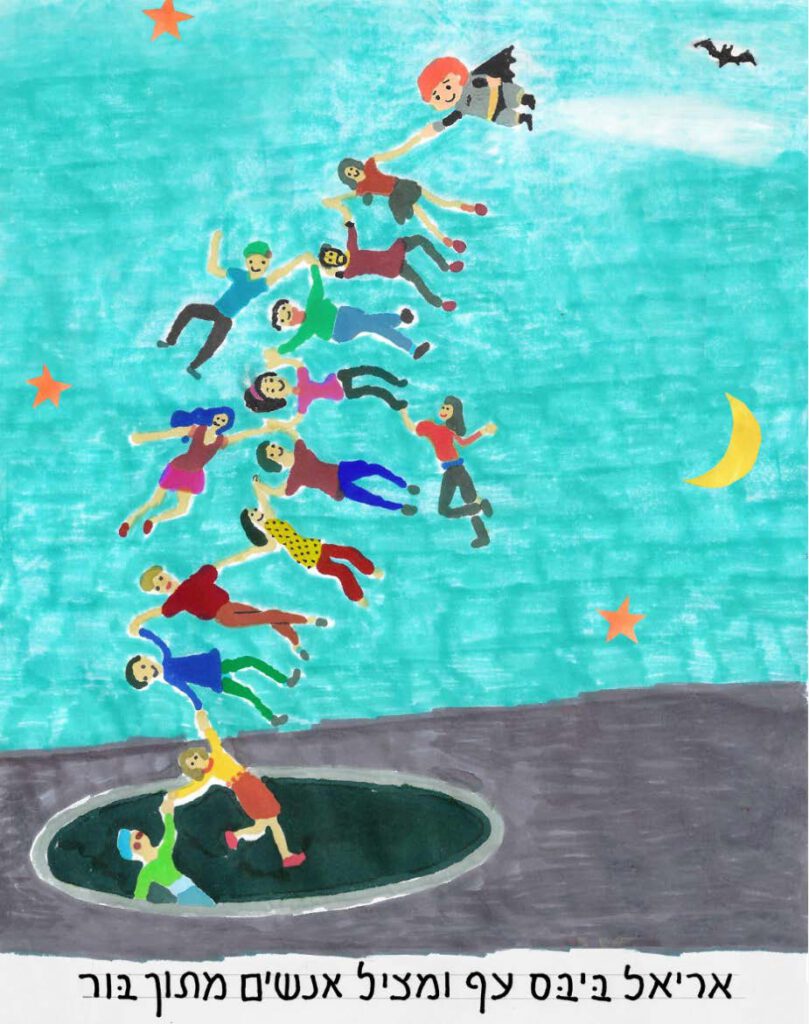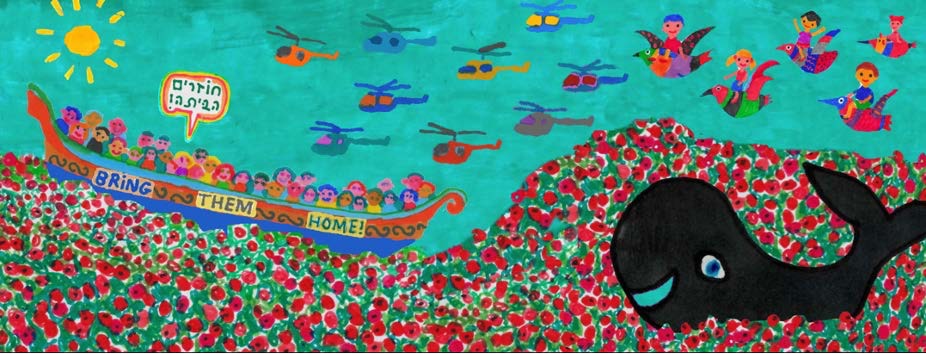Imagining a hopeful future for Israel through art: A conversation with Israeli artist Zeev (Shoshke) Engelmayer
A glimpse into the creative process of the artist behind The Daily Postcard
who inspired M²’s Yamim educational resource

Ariel Bibas flies and saves captives from the pit / Zeev Engelmayer, The Daily Postcard
Trigger Warning: This article contains references to the abduction and murder of individuals on October 7th. The content may be triggering for some readers. Reader discretion is advised.
With a helicopter, umbrella, and rainbow, the imagery in “The Daily Postcard” imagines the people taken hostage on October 7th flying home to Israel in vivid color. These are just a few of the scenes from the project, created by Israeli artist and illustrator Zeev Engelmayer.
Now, through a collaboration with M²: The Institute for Experiential Jewish Education, postcards from Engelmayer’s series have been transformed into an educational resource, “The Daily Postcards: Imagining the Happiest Day.” Amid the darkness of tragedy and uncertainty, Engelmayer’s bright representations capture an optimistic vision of smiling faces and blossoming fields as the hostages return home, and bring to life stories of those who were murdered.
The resource was first presented at the Yamim Project workshop series hosted by M² in six communities and online, bringing together more than 500 educators to design high-quality, meaningful, and engaging programs for their learners and communities to recognize the first Yom Hazikaron and Yom Ha’Atzmaut since the attacks. The postcards inspired exercises on the relationship between hope and optimism, artistic analysis, and reflection. Learners were asked to harness the power of creativity to process trauma while remaining resilient amid crisis.
In a discussion summarizing their collaboration, Engelmayer spoke to Shlomit Naim Naor, M² Program Director, about his vision, process, and what it means to be an artist in a time of war, offering us a glimpse into his inspiring creative process. Their interview has been translated and condensed below.
******
Between Hope and Reality: An Act of Resistance
Shlomit Naim Naor: How did the Daily Postcards project start?
Zeev Engelmayer: Initially, painting was a way to disconnect. From news outlets to social media, everything following October 7th was saturated with violent images, and I needed to escape the violence. With the postcards, I created an alternative reality but not a disconnected one. Many people found resonance in this and its optimism.
SNN: What gives you hope?
ZE: All the people who want to rebuild Israel, who are looking towards the future and taking action — that’s hope for me. I see the courage and sacrifice in the people I meet. Ayelet, the mother of Naama Levy [a 19-year-old female Israeli soldier who was taken hostage from Nahal Oz military base and has been held in Gaza by Hamas since October 7th], for example, lives in a nightmare. She saw her daughter bleeding, being violently led away, and yet, you see the determination with which she does everything she can to keep her life going. There are many like her — many people who have lost so much, their entire families. When you see them, you understand that our hope is not yet lost. Seeing people gather and taking action strengthens them. You don’t come to demonstrations if you don’t have hope. Protest is an act of hope, not of despair.
SNN: How would you describe the Daily Postcard’s style?
ZE: Unlike my other work, they are hand drawn, not done by computer. They are not necessarily pretty, but I want to see captives coming out of captivity. Whether the portrait is similar or not is of no importance. I painted three 17-year-olds who were murdered at Zikim Beach sitting on the moon and fishing. The parents of one of them, Tal Keren, from Netiv HaAsara, hung it in their living room. The likeness is not very similar, but there is camaraderie and friendship. I try to reflect their essence.
SNN: How do you deal with the fact that some of the hostages won’t return?
ZE: It’s obviously very tragic, and it’s related to the passing of time. Released hostages I’ve met like Norberto Louis Har have told me they greatly feared the bombing in captivity. It’s like an earthquake – every day and every hour is a life-threatening situation. Information is scarce and what we hear is often inaccurate. In some cases, we don’t know what the circumstances were around people’s deaths. For the hostages still in captivity, dying is a terrible threat. We need to increase the pressure, and the only way is to reach a swap deal for their release, with hostages alive and healthy. Too many hostages remain in Gaza. What will happen to the rest?
SNN: You have been working on this project for 220 days, and Israel has been at war for 227 days. What have you learned and how has your artistic process evolved?
ZE: I learned about art’s ability to encompass the world. In this project, the postcards are handmade and emotional. I took my art and turned it into an agenda I want to promote. From the beginning, I haven’t signed any of the works in the postcard project. It’s unusual because I‘ve always thought that signing my work was important and makes me part of the creation. But since the war started, I put myself in the background.
Usually I get a written text, illustrate it, and then meet with the family to form a connection. When we read about the murders, the articles focus on the last hours, the violence. I thought about what an injustice this does to a person, when you know how they were murdered and not who they were. I painted the Kutz family [Livnat and Aviv Kutz, who were murdered at their home in Kfar Aza on October 7th, together with their three children, Rotem, Yonatan, and Yiftach] in their blooming, beautiful environment, holding kites. It’s a picture of memory, not how they were killed. Violence attracts the eye, but I decided not to paint the violence.
The postcards make it possible to remember the murdered with life and beauty. I painted Alex Danzig [a 75-year-old scholar and historian of the Holocaust, who was taken hostage from his home in Nir Oz] running barefoot in the fields because his daughter, in her account of his academic achievements as a Holocaust expert, noted that he also loves to walk barefoot in the fields. When I painted Dror Or [a 48-year-old hostage from Kibbutz Be’eri who was since declared murdered], I thought about his loved ones’ recollections of his choice to be a cheesemaker, a yogi, and a peace-loving person. Their descriptions of his peaceful nature gave me the color palette for his portrait, a scale of gentle, quiet blues.
This project is very personal. The hours I spend connecting with the person I’m painting are irreplaceable. That’s why I’ve chosen to create these postcards manually. It’s a bit like shrouds, beautifying the moment of death, accompanying the dead, and giving them eternal life.

Returning Home / Zeev Engelmayer
To learn more about the stories of the hostages, visit everyonecounts.live